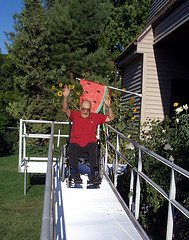Disclaimer: This page may contain affiliate links. We may earn a small commission for purchases made through links in this post, at no extra cost to you.
Weakness is common for MSers
Experiencing weakness in MS is not the same as experiencing fatigue. Usually one side of the body will be weaker than the other. One leg, for example, will feel weaker. For Cir, this is in his right leg. To a lesser degree, it can also effect his other leg depending on what he is doing or how he's feeling.
His left leg can be effected when he gets sick. It is a temporary symptom that improves as he feels better. The right leg stays that way pretty much all the time.
If Cir gets a UTI (urinary tract infection), I step in and help more. Getting in and out of bed by himself is almost impossible. He is not able to walk the short distance from our bed to the bathroom.
Once the infection and fever are past, the inflammation goes away. He goes back to the same level of strength he had before he started.
How does your leg feel when you have this symptom? Cir describes it as a feeling of heaviness. He is not able to lift his leg from the hip and very rarely from the knee. No matter how hard he tries, the signal from his brain won't get through.
If one of your legs is weaker, your walking will also be effected. You may notice that you experience this after a day spent standing or walking too much. Get to know your body and how much you can do at one time.
Resting and conserving his energy before going out, helped a lot when Cir was first diagnosed. The same can be true for you. If you know you have a big event, rest up a few days before it. Afterward do the same.
Mobility aide or fashion statement
As time goes on, you may find that rest is also not enough. That's when mobility aides come into play. Whether it's a cane or walking stick, walker or rollator, wheelchair or electric scooter, if you need it, use it.
It took Cir a long time to get to the point of using a cane. He was very self-conscious. He didn't like it that people might see him differently. At least in his perception.

After losing his balance and falling a few times too many, he finally gave in. His first cane was a wooden one made from walnut. He still has it today. It looks more like a fashion statement than a mobility aide.
He had several answers for when people he didn't know asked why he used it. Most of the time he would say something like he'd hurt it in some sort of accident. He hardly ever told anyone he had MS.
Foot drop
When Cir eventually developed foot drop in his right foot, he also had to begin wearing orthotics. At first the physical therapist ordered one for each foot. A few years later his doctor felt he only needed an AFO (ankle-foot orthosis) for his right leg.
When the ankle is weak, the foot will drop as you swing your foot through to take a step forward. You are at an increased risk of tripping and falling when this happens. An AFO helps with this by holding your ankle and foot in one position.
The AFO, a plastic, L-shaped brace fits inside your shoe. It keeps your foot bent in a slightly upward position. As your foot swings through, your toe remains locked in place. The result - you won't trip over your own toes!
The first AFO's Cir received were a little heavier and thicker than the one he has now. Also, his sneakers had to be at least one full size larger to accommodate them. This was another source of frustration for him.
He already had to wear these plastic foot braces. Now he had to wear a big pair of shoes, as well. He had to admit, though, that he did feel safer when he wore them.
Knee buckling
A longer leg brace may be necessary, however this is rare. If your knees have a tendency to buckle and give way, a leg brace may be used to keep it locked.
Weakness at the hip and ankle may make the brace to heavy to wear. This would defeat the purpose of wearing. You want to use aides that will help conserve your energy. With a heavy leg brace, you would get more tired while walking instead of less.
Physical therapy
Physical therapy is sometimes ordered for the patient dealing with MS. The therapist should, however, be trained in treating someone with leg weakness. The best therapist would be someone trained with a specialty in MS.
Cir has dealt with therapists who have not had any knowledge of the challenges people with multiple sclerosis face. And believe me, it has not been pretty.
The therapist would try to do “their job” by insisting that he “try harder” or do more. Cir would let them know, in no uncertain terms, that he couldn't at the time because of weakness, fatigue, or whatever.
Water therapy is better
When a therapist is knowledgeable about MS, they know what types of exercises should be done and when they should be done. One of his therapists at an MS center had him do water exercises once a week. The end of those sessions came all to soon. He always wished he could stay just a little longer.
Water therapy or hydrotherapy is one of the best options for treating this particular symptom. Because you feel weightless, it's so much easier to move your legs further than on land.
Some untrained therapists may also feel that by strengthening the weak leg or legs, any future weakness can be avoided. But the weakness comes from the nerves from the brain to the legs not working properly. Making a muscle stronger won't cause a nerve to work better. And it won't keep you from having a future attack.
Weakness in both legs?

If you have weakness in both your legs, then you really should use a walker, rollator, or wheelchair. The point is to learn to conserve your energy and manage your symptoms. Learn how your body reacts at certain times of the day. You may be able to get away with just using your walker or cane.
When Cir was able to get an electric scooter, this opened up many more activities to him. Now we could go for walks and he was in control. We were able to take the scooter apart and take it with us to the mall or other places that required him to walk long distances.
Check with your local National MS Society to see if they have an MS Loan Closet. Because of charitable donations, Cir's wheelchair, electric scooters and other durable medical equipment (DME) have been free. He just agrees to give them back when he no longer needs them. This way many people can benefit.
Give them a call. You'll be glad you did.
Dear Friends,
"Life in Spite of MS is a participant in the Amazon Services LLC Associates Program, an affiliate advertising program designed to provide a means for sites to earn advertising fees by advertising and linking to Amazon.com. We're also part of the Ebay Partner Network, another affiliate program."
We'd also like you to know it doesn't cost one cent more when you click through the links here on our blog. Not one single penny. And we will make a little extra cash when you do click through. We'll be ever so appreciative. You also have our word that we'll only link to things that we would use ourselves, (or wish we could have or use).
Sincerely,
Cir & Akrista
You are reading original content written by Akrista or Cir L'Bert of Life in Spite of MS. If you enjoyed reading this blog, please consider following us on Facebook, Twitter, Pinterest, and Instagram. See you there!
Privacy Policy ~ Advertising Policy ~ Disclaimer ~ Contact Us ~ About Us

New! Comments
Have your say about what you just read! Leave me a comment in the box below.